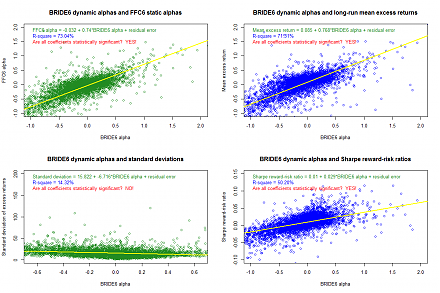

2022-10-15 09:34:00 Sat ET
corporate finance corporate cash management cash-to-assets ratio internal capital market precautionary motive agency theory managerial entrenchment excess cash utilization offshore tax avoidance liquidity risk refinancing risk internal capital allocation corporate diversification rene stulz jarrad harford
Duchin (JF 2010) empirically finds that multidivisional firms with robust internal capital markets retain about half as much precautionary cash balances as highly specialized firms do. These multidivisional firms enjoy the benefits of coinsurance. This coinsurance reduces their exposure to distress risk and allows them to hold lower precautionary cash in contrast to their standalone counterparts. Duchin and Sosyura (JF 2013) mark a clear watershed between the bright and dark sides of internal capital markets. The bright-side view posits that multidivisional firms benefit from fewer information asymmetries while this benefit helps with better fund allocation (Naveen and Tice, JF 2001; Maksimovic and Phillips, JF 2002). The dark-side view suggests that multidivisional firms suffer from the divisional managers' pursuit of private interests in the form of managerial rent (Scharfstein and Stein, JF 2000; Rajan, Servaes, and Zingales, JF 2000; Ozbas and Scharfstein, RFS 2009). In multidivisional firms with robust corporate governance, social ties between the CEO and each divisional manager positively correlate with investment efficiency and firm valuation. In multidivisional firms with subpar corporate governance, social ties between the CEO and each divisional manager negatively correlate with investment efficiency and firm valuation. In essence, the bright and dark sides of internal capital markets often reflect the quality of corporate governance (in terms of the G-index, the E-index, or the index for anti-takeover provisions etc). Sound corporate governance limits managerial entrenchment and rent protection and therefore helps improve investment efficiency and firm valuation.
To the extent that corporate diversification relaxes the firm's financial constraints, this relaxation should manifest in the complementary metrics of financial-constraints risk. These metrics of financial-constraints risk include the Kaplan-Zingales index (Kaplan and Zingales, QJE 1997; Lamont, Polk, and Saa-Requejo, RFS 2001), the cash flow sensitivity of cash (Almeida, Campello, and Weisbach, JF 2004), the Whited-Wu index (Whited and Wu, RFS 2006), and the cash flow sensitivity of investment (Fazzari, Hubbard, and Petersen, BPEA 1988). The econometrician can use Tobin’s q excess value imputation to gauge the degree of corporate diversification. Also, the econometrician can calculate a wide variety of descriptive statistics, especially Sharpe ratios, across the full sample, the subsamples for dictatorship and democracy, and the excess-value decile ranks.
Financial constraints risk quantification follows several landmark empirical studies:
Fama-MacBeth (JPE 1973) cross-sectional regressions help determine whether multidivisional diversification helps better decipher:
Fama-French (JFE 1993, JFE 2015), Carhart (JF 1997), and Hou-Xue-Zhang (RFS 2014) time-series regressions help assess whether greater corporate diversification yields econometrically significant long-run multi-factor alphas and Sharpe ratios. Further, the econometrician can carry out the event-time convention of Denis and Sarin (JF 2001), Chan, Ikenberry, and Lee (JFQA 2004), Titman, Wei, and Xie (JFQA 2004), and Chen, Chen, Liang, and Wang (JFQA 2014) to compare the abnormal returns for both corporate diversifiers and their standalone peers around major earnings announcements. Developing robust internal capital markets can yield tangible corporate diversification benefits in the form of higher Sharpe ratios, investment efficiency gains, and higher operating synergies in the long run. A geometric interpretation suggests that the better development of internal capital markets pushes the efficient frontier outward in the northwest direction.
An empirical analysis of the interaction between cash management and banking relationship management at Kauffman Firm Survey (KFS) private firms shines fresh light on the pure precautionary motive for cash stockpiles in the absence of agency conflicts. The econometrician develops the *banking relationship hypothesis* that private firms with multiple banking relationships retain less cash for precautionary motives in comparison to private firms with no banking relationships, even during tight credit years of the global financial crisis 2008-2009. Private firms with more multiple banking relationships have greater financial flexibility in the form of available debt capacity that private firms with no banking relationships appear to lack, especially under severe macroeconomic downturn conditions.
This analytic essay cannot constitute any form of financial advice, analyst opinion, recommendation, or endorsement. We refrain from engaging in financial advisory services, and we seek to offer our analytic insights into the latest economic trends, stock market topics, investment memes, personal finance tools, and other self-help inspirations. Our proprietary alpha investment algorithmic system helps enrich our AYA fintech network platform as a new social community for stock market investors: https://ayafintech.network.
We share and circulate these informative posts and essays with hyperlinks through our blogs, podcasts, emails, social media channels, and patent specifications. Our goal is to help promote better financial literacy, inclusion, and freedom of the global general public. While we make a conscious effort to optimize our global reach, this optimization retains our current focus on the American stock market.
This free ebook, AYA Analytica, shares new economic insights, investment memes, and stock portfolio strategies through both blog posts and patent specifications on our AYA fintech network platform. AYA fintech network platform is every investor's social toolkit for profitable investment management. We can help empower stock market investors through technology, education, and social integration.
We hope you enjoy the substantive content of this essay! AYA!
Andy Yeh
Chief Financial Architect (CFA) and Financial Risk Manager (FRM)
Brass Ring International Density Enterprise (BRIDE) ©
Do you find it difficult to beat the long-term average 11% stock market return?
It took us 20+ years to design a new profitable algorithmic asset investment model and its attendant proprietary software technology with fintech patent protection in 2+ years. AYA fintech network platform serves as everyone's first aid for his or her personal stock investment portfolio. Our proprietary software technology allows each investor to leverage fintech intelligence and information without exorbitant time commitment. Our dynamic conditional alpha analysis boosts the typical win rate from 70% to 90%+.
Our new alpha model empowers members to be a wiser stock market investor with profitable alpha signals! The proprietary quantitative analysis applies the collective wisdom of Warren Buffett, George Soros, Carl Icahn, Mark Cuban, Tony Robbins, and Nobel Laureates in finance such as Robert Engle, Eugene Fama, Lars Hansen, Robert Lucas, Robert Merton, Edward Prescott, Thomas Sargent, William Sharpe, Robert Shiller, and Christopher Sims.
Follow our Brass Ring Facebook to learn more about the latest financial news and fantastic stock investment ideas: http://www.facebook.com/brassring2013.
Follow AYA Analytica financial health memo (FHM) podcast channel on YouTube: https://www.youtube.com/channel/UCvntmnacYyCmVyQ-c_qjyyQ
Free signup for stock signals: https://ayafintech.network
Mission on profitable signals: https://ayafintech.network/mission.php
Model technical descriptions: https://ayafintech.network/model.php
Blog on stock alpha signals: https://ayafintech.network/blog.php
Freemium base pricing plans: https://ayafintech.network/freemium.php
Signup for periodic updates: https://ayafintech.network/signup.php
Login for freemium benefits: https://ayafintech.network/login.php
If any of our AYA Analytica financial health memos (FHM), blog posts, ebooks, newsletters, and notifications etc, or any other form of online content curation, involves potential copyright concerns, please feel free to contact us at service@ayafintech.network so that we can remove relevant content in response to any such request within a reasonable time frame.
2019-08-07 12:33:00 Wednesday ET

Conor McGregor learns a major money lesson from LeBron James. This lesson suggests that James spends about $1.5 million on his own body each year. The $1.5
2019-12-16 11:37:00 Monday ET

America and China cannot decouple decades of long-term collaboration in trade, finance, and technology. In recent times, some economists claim that China ma
2023-01-03 09:34:00 Tuesday ET

USPTO fintech patent protection and accreditation As of early-January 2023, the U.S. Patent and Trademark Office (USPTO) has approved
2018-09-29 12:39:00 Saturday ET

The Securities and Exchange Commission (S.E.C.) sues Elon Musk for his August 2018 tweet that he has secured external finance to convert Tesla into a privat
2018-08-07 07:33:00 Tuesday ET

President Trump sounds smart when he comes up with a fresh plan to retire $15 trillion national debt. This plan entails taxing American consumers and produc
2019-03-19 12:35:00 Tuesday ET

U.S. tech titans increasingly hire PhD economists to help solve business problems. These key tech titans include Facebook, Amazon, Microsoft, Google, Apple,